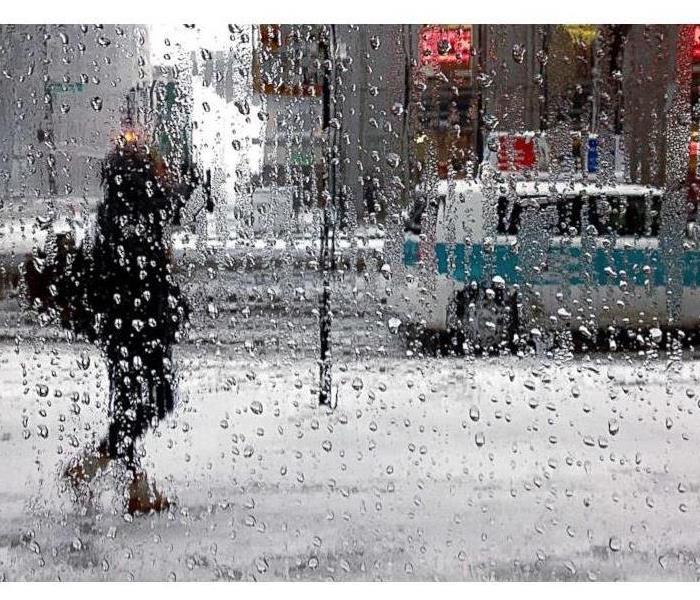Recent Storm Damage Posts
Homeowners and Renters Insurance Coverage
9/22/2022 (Permalink)
Do you live in Langhorne with renter’s insurance or homeowners insurance? Do you know what your insurance covers if you are hit with water damage?
No worries, SERVPRO of Langhorne/Bensalem has your back. Our partnership with State Farm has allowed our professionals to understand the ins and outs of insurance. Here is what renter’s insurance covers - in short, it covers all the things you own.
Accidents - this includes objects damaging your property
Weather impacts - any damage resulting from a natural
Malicious mischief - this includes vandalism, theft, riots, & vehicle damage
Loss of use - if your home or property is damaged and uninhabitable after a covered loss, living accommodations and expenses that accrue will be covered by this type of insurance.
According to Forbes and the Insurance Information Institution, every year about one in 50 homeowners file water damage claims, accounting for 29% of all homeowners insurance claims. It is important to be aware of what your insurance covers and the steps to take in the event of water damage.
SERVPRO of Langhorne/Bensalem takes pride in relieving stress from our customers and clients. Our professionals are equipped with the knowledge and resources to be the middle person between our business and their insurance claims.
Is Your Langhorne Business Emergency Ready?
9/6/2022 (Permalink)
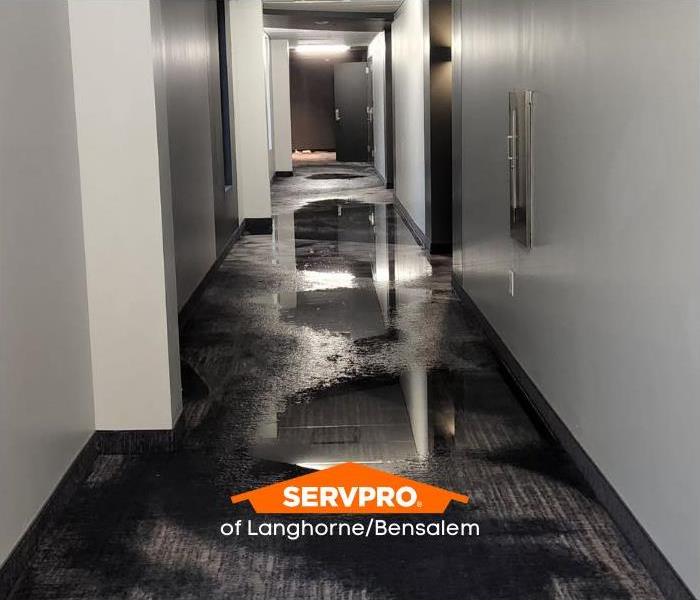 Hallway flooded in apartment complex
Hallway flooded in apartment complex
ARE YOU READY FOR WHATEVER HAPPENS?
No one plans for disasters, but that doesn’t mean you don’t have too. Partnering with SERVPRO of LanghorneBensalem, ensures you’re ready for whatever happens to your business or commercial property. By preparing now, you demonstrate excellence in readiness planning by compiling a comprehensive information resource to use in case of a disaster.
WHY SERVPRO’S EMERGENCY READY PLAN?
By having an immediate plan, you minimize potential business downtime when disaster strikes. Here’s why SERVPRO’s ERP is the way to go!
- 50+ years in disaster recovery experience
- 2,000+ service provider locations
- This means there is a SERVPRO in your area within a two-hour distance
- 20,000+ SERVPRO Personnel
- No Retainer/Upfront Costs
- SERVPRO’s Emergency Ready Plan is completely free to utilize. We will come out to do a free assessment of your property while storing all the property information in one place.
- Largest Supply of Owned Equipment
Our Ready Plan is designed to be a start-up approach that provides critical information needed to begin mitigation and recovery services.
If you and your business are interested in learning more about our ERP profile, please contact our offices at 215-245-4855.
Tips for Protecting Your Windows from Storm Damage
12/29/2021 (Permalink)
Staying safe during a storm can be challenging, but protecting your windows from damage is an easy way to ensure that you and your family are prepared for any emergency. Storms like Hurricane Harvey create dangerous conditions – often times shattering windows and flooding homes – which is why it's important to take precautionary measures now before the next big hurricane hits. With these tips, you'll be ready when the next storm comes!
Have High Impact Glass Windows on Your Property
Having high impact glass windows on your property can make all the difference when it comes to protecting your home during a hurricane. These days, there are many window options that will hold up against powerful winds and heavy rains – even if they shatter! It's always best to invest in these types of windows before an emergency arises; this way you'll be prepared for any situation that may happen.
Get Storm Shutters
Storm shutters are an excellent way to protect your windows from damage. These easy-to-install blinds can be attached directly over any window, and they will prevent dangerous storm debris like glass shards or branches from coming through the glass.
Purchase and Apply Hurricane Window Film
While storm shutters are great for protecting your windows from debris, they won't prevent the glass itself from breaking. To ensure that no dangerous shards of glass come through during a hurricane or any other high-intensity weather event, it's smart to invest in some type of window film. Hurricane window films work by filling up shattered windows with air bubbles – thus stopping them from shattering into pieces when hit with strong winds!
Avoid Open Windows during a Storm
As tempting as it might be to watch the rain pour down outside while enjoying a cup of tea, staying away from open windows is an important step to ensuring safety during storms and hurricanes. By opening your windows before a storm hits you're allowing wind gusts and heavy rains to penetrate your home, which can cause damage to the inside.
Do Not Use Tape On Your Windows
Taping windows with masking tape is a popular method of protecting homes from storm damage; however, it's not actually safe. The glue in regular masking tape will melt during high-intensity storms and become extremely dangerous for anyone who walks by – especially children! In fact, there have been many cases where people were severely injured after walking into pieces of melted masking tape that had fallen off their own window while they weren't looking.
Use Plywood and Wooden Panels to Protect the Windows
Plywood and wooden panels are another great way to protect windows from strong winds, heavy rains, and dangerous debris. They come in a variety of different sizes and thicknesses depending on the weather event you're preparing for – so make sure you purchase them before an emergency arises!
5 Ways to Protect Your Belongings during a Storm
11/30/2021 (Permalink)
We've all been there. You're sitting in your home, anxiously waiting to hear if the storm that is heading towards you will be a Category 2 or 3. It's not until hours later when it has passed do you go outside to survey the damage. If you were lucky, only some of your property was damaged and everything else was still intact; but if you weren't so lucky, then this article may help stop future disasters from happening again! Here are five ways to protect your belongings during a storm.
Store important documents In a Safe Place
One of the simplest and most effective ways to protect your belongings during the storm is to place them in a safe place. This will not just save your belongings from getting damaged but it will also be great if you have to rush and evacuate due to the storm warning. A great option for this would be an Under Bed Safe, which you can easily store underneath any bed or heavy piece of furniture so that no one will ever think twice about it being there. This type of safe has been known not only to lock away documents but also jewelry, money, cameras, laptops, etc.
Place any items that can be blown away, such as plants or decorations, inside of the house
If you have any items in your yard that are not too heavy, then it is best to bring them inside the house or into a garage. This includes plants, decorations, and furniture. It may be fine for these types of objects to get damaged during just one storm but if they're outside when multiple storms happen back-to-back then there's no telling how much damage can occur!
Keep appliances unplugged
If you have any appliances that are not in use, then it is best to unplug them during the storm. If they get damaged due to power surges caused by lightning or rain/snow entering through poorly-sealed doors and windows, then this can become very costly! It's also a good idea to keep all of your electronics plugged into surge protectors so that if there does happen to be an electrical problem, these items will still remain safe (just make sure they're turned off).
Make sure you have multiple flashlights/lanterns around for when there is no power available due to storms which happen often lately
This is an essential item to have in any house, especially if you live in a rural area. There are many times where the power goes out for days at a time due to storms and it can be very annoying when there's no light or heat available! To solve this problem, make sure that you always keep flashlights/lanterns with candles on hand so that you won't ever have to worry about feeling completely powerless during a storm again.
Park the Car inside the Garage So the Storm Does Not Damage It
This is a relatively small but very effective way to protect your car from damages caused by the storm. If you live in an area that gets heavy storms then it might be best just to always park inside of your garage during such times so that there will no longer be any chance of water, hail, and/or fallen branches damaging it!
These are some great ways for how to care for your belongings during a storm which should hopefully stop future disasters from happening again.
How to Fix Your Roof after a Storm
11/30/2021 (Permalink)
It's not often that disaster strikes but when it does, you want to make sure you are doing everything correctly, from start to finish. When the roof has been severely damaged by wind or hail, it can be one of the more costly repairs on your home. The main concern during this time period is safety from falling objects such as tree branches or other debris. This article is a guide for homeowners on what they should do after a storm has passed and left its wake of devastation in the form of shingles, shingles debris, and leaks that have sprung into their ceilings due to storm damage.
Now what? Whether you had a little damage or a lot of damage, a quick response is very important if you want to save your roof and reduce the potential for more leakage.
First make sure that it is safe to enter your home. If there are any toppled trees or limbs, remove those before entering the house. Once inside, if there is water in your ceilings and/or walls then it is time to call a professional roofer.
For minor damages like blocked gutters or missing shingles caused by wind gusts, wait until it stops raining and immediately check your roof with binoculars for any immediate danger of further damage such as loose tiles or hanging parts of the structure. If you have a partial shingle loss, be sure to nail down the tiles that are still attached. If your roof is in need of replacement, call for an estimate before performing any repairs or replacements yourself.
Soaking up water - Blocked gutters are the main cause of water damage when there is heavy rain over time
Removing debris - If you come across any loose tiles caused by high winds then remove them and nail down any metal ridge caps that might have popped out of place during the storm
Checking your shingles - Check with binoculars for blown off parts of the structure including missing shingles and loose tiles
Assessing the damage - Generally speaking, if there has been any shingle loss then it is time to call a professional roofer for an estimate. A restoration company will be able to tell you if you need to get a new roof or just get the one you already have restored. The restoration services like SERVPRO will tell it to you how it is. If we feel that the roof may not stand another storm we would recommend getting a new roof otherwise we will restore it for you.
Making temporary repairs for leaks in between rafters until the restoration company arrives. It is important to hire a storm damage restoration company if you want to get your roof in good condition. Don’t forget to contact your insurance company as well so you don’t have to pay much for the restoration or repair of the roof.
The Top 5 Reasons Why Insurance Companies Deny Your Claim for Storm Damage
11/30/2021 (Permalink)
As a homeowner, you assume that your home is covered by insurance against a variety of threats and losses. Whether it's the threat of fire, water damage from a busted pipe or even theft, you hope insurance will be there for you when disaster strikes. But what happens if your insurer refuses to pay for damages because of an exclusion in the policy? Just because you don't have clear title to your property doesn't mean it can't be insured. In many cases, insurers will cover these types of conditions as long as the buyers have been made aware before closing on the house.
When you’re foreclosed on and Still Owe Money to the Lender
If you're foreclosed on and still owe money to a lender who holds a lien on your property, most policies won't cover damage to the structure. Before you buy a foreclosed house, get advice from your insurance agent about what types of coverage are available for you before buying it.
There can be several reasons for why insurance companies may deny your claim. Here are the top five reasons why an insurer may deny your claim for damages caused by a storm or other casualty:
- You didn't have sufficient homeowners' insurance coverage in place at the time of loss.
- You don't have clear title to your property can be another reason for why your insurance company may deny your claim.
- You didn't follow the proper procedure for reporting a loss, such as notifying your agent or insurer immediately after a storm hits.
- The damage occurred due to neglect on your part, such as failure to cut down a tree that threatens your house's structural integrity.
- The damage was caused by an excluded peril, such as faulty repair work done on your home following a prior loss.
As frustrating as it can be insurers refuse to pay for damages, it's important to remember that their denial doesn't mean the damage didn't occur. It simply means that you couldn't prove, with your policy in place, that they were obligated to cover the loss. This is why it is very important to take photographs of your house when you know that there is a storm coming
When You Can Sue Your Insurance Company for Denial of Coverage
If your insurance company denies coverage for storm damage or any other kind of disaster, you may have recourse through state law. Check with a local attorney about whether you can file a claim based on breach of contract if the insurer refuses to pay out on your homeowners' insurance policy. Also contact your state department of insurance for more information about what remedies are available under the law if an insurer denies your claim.
Can You Do DIY Home Restoration after a Storm?
11/17/2021 (Permalink)
Can You Do DIY Home Restoration after a Storm?
If you are living in a house that gets damaged because of a storm, or something similar to it, do not be alarmed. Whether someone else is doing the repairs for you or you are doing them yourself, there are things to keep in mind. The tips will help make your home restoration go smoother and more quickly.
Steps for DIY Home Restoration:
1.) Consider an insurance policy if one has not been obtained already. If there is damage, this should help out with costs involved with the restoration process.
2.) Before beginning any kind of repair work always wear protective gear including safety goggles and gloves so that no dust particles get into your eyes or worse enter your body through open cuts on hands etc. If possible wear breathing masks as well.
3.) Start by removing furniture if it had not already been done. If there is damage on the floor remove it before putting the furniture back in its place.
4.) Next, cover all windows and exterior doors with plastic sheeting. This will keep any moisture from entering your home which could cause mold or mildew to begin growing in places that were not damaged such as under carpets and sinks.
5.) After everything has been covered then use a vacuum cleaner to clean up any debris left behind after cleaning up water stains etc...The next step would be to remove any wet items such as clothes, bedding and blankets and run them through a washing machine several times so that no mold grows on them while they are stored away.
6.) You should look to see if the roof has been damaged and determine whether or not you want to fix it yourself or have someone who knows more about roofs do the work for you. It is possible to patch up a roof, but this does depend on where the damage is and how big it is because sometimes roofs will need to be replaced all together due to too much damage.
7.) If everything has dried out enough so that mold will not begin growing, take out all floor boards in affected areas so that they can be sanded down and treated with fungicide before replacing them back into place. Then cover area around walls with plastic sheeting again to keep dust from entering other areas of the house while new boards are being put back into place.
8.) Now that everything has been repaired it is time to start cleaning again and get rid of any lingering moisture in carpets and under sinks by using a dehumidifier.
So all of this can be done by you however if you want an ideal restoration process then it is better to hire a storm damage restoration service. A professional storm damage restoration service can do wonders for you and make your house look as good as new.
Choosing the Right Storm Damage Restoration Company
11/17/2021 (Permalink)
Choosing the Right Storm Damage Restoration Company
In the aftermath of a tornado, hurricane or other major storm, one of the most important tasks facing homeowners is finding a reputable and reliable emergency restoration contractor to get the job done.
A number of factors need to be considered in order to choose a company that can do an effective job without taking advantage of stressed-out clients who are not thinking clearly during a disaster.
Preparation:
It's important for people to plan ahead and get several estimates from local companies before a major storm hits. Then, homeowners should get references and check them so they know who they can trust when an emergency happens.
The business of restoring homes hit by disasters such as tornadoes is highly competitive. That's why unscrupulous restoration contractors might cut corners or otherwise take advantage of their clients in the aftermath of a disaster. Getting multiple bids beforehand will help a homeowner avoid a dishonest company that focuses on profits over quality workmanship. If there isn't time to gather several proposals, it's wise to at least ask neighbors or friends for referrals rather than going with the first contractor who comes knocking on the door during a crisis situation.
Proper Licensing
Typically, the most effective way to find a quality restoration contractor is by word-of-mouth from satisfied clients. It's wise to ask the company for references and speak with those they have worked for in the past.
In addition, homeowners should check whether they are properly licensed, bonded and insured. There might be a cost associated with this process but it could provide a degree of protection against fraud or shoddy workmanship if something goes wrong. For example, insurance companies typically will not pay out claims unless a restoration company is properly licensed and insured as required by law in that area. If an insurer refuses to pay up when problems arise after work has been done, having licenses and insurance will help make sure contractors do everything possible to make things right.
Experience of the Storm Damage Restoration Company:
A homeowner should also consider the number of years a restoration company has been in business. An established and respected organization is more likely to do quality work than a fly-by-night outfit that might not be around after the storm damage is repaired.
Time the Restoration Company Devotes To Your Property
The amount of time an emergency contractor devotes to customer satisfaction is another important factor, particularly with companies that often deal with crisis situations such as hurricanes and tornadoes. Satisfied clients can provide invaluable referrals, which usually helps generate new business opportunities.
It's wise to avoid restoration companies that pressure their customers into signing contracts on the spot during a time of stress and chaos. A responsible company will allow home and property owner’s sufficient time to review all terms and conditions before making any decisions about hiring them.
A written contract should include an itemized list of all work to be done, along with the estimated cost. It's in a homeowner's best interest to make sure the agreement also covers any additional expenses in case repairs are needed later on that might not have been foreseen by the restoration company or homeowner at the time of signing.
Why Your Home Needs A Professional Storm Cleanup Service
9/10/2021 (Permalink)
Why Your Home Needs A Professional Storm Cleanup Service
A storm causes a lot of destruction in its wake. The chaos it creates is too much to deal with. This is why residential owners need extra help to restore their homes after a storm.
For this, you will need the service of a professional company that deals in storm damage restoration and cleanup such as us. After all, your home is your sanctuary and it needs to be protected so you can be safe.
Here are the many reasons why your home will need a professional storm damage restoration service.
Quick Cleanup And Repair
The damage that storms can cause can be extensive. You and your family can't possibly repair it in time and you will need a few days or a week to restore it yourself. However, because of this, you may feel unsafe in your own home.
Hiring a professional storm cleanup service means that your house will be restored to its original form in no time. This is because we are experts at what we do and we can quickly and effectively repair any damage caused by the storm around the house.
Professional Evaluation
As a layman, you will not know where to look for damage. You might miss out on a few things that should be repaired so your house can function well and live a long life.
Hiring a professional service will mean that they will do a full evaluation of your house first. This means that the experts will search every corner of the house to see the extent of the damage.
Apart from that, they will figure out what needs to be fixed through a detailed inspection and evaluation of your property. They will then come up with a solution to fix all the damage.
Clean And Sanitized Home For Optimal Health
Storm damage can cause contamination, infections, parasites, and diseases. These are serious issues that need to be addressed as soon as possible. If these issues exist then they will come to light when the experts do the inspection and evaluation.
As a professional cleanup service, our main priority is your health and we will do everything to ensure that it is not harmed. This is why your home will be thoroughly cleaned and sanitized to get rid of any contamination and infection. You can then go back to enjoying a safe and healthy home.
Flooding Will Be Taken Care Of
Storms can cause flooding in basements and other areas. However, we will clean it up through the use of our flood pumps to get rid of all the water and to prevent it from seeping into your walls.
As a professional cleanup service, we have all the equipment and expertise to execute the restoration effectively.
Final Words
Please don’t attempt to restore the house yourself after storm damage. Instead call professionals and experts such as us to effectively clean and restore your house to its original form.
For more information, feel free to get in touch with us now.
How Business Interruption Insurance Differs From Other Insurance
5/25/2021 (Permalink)
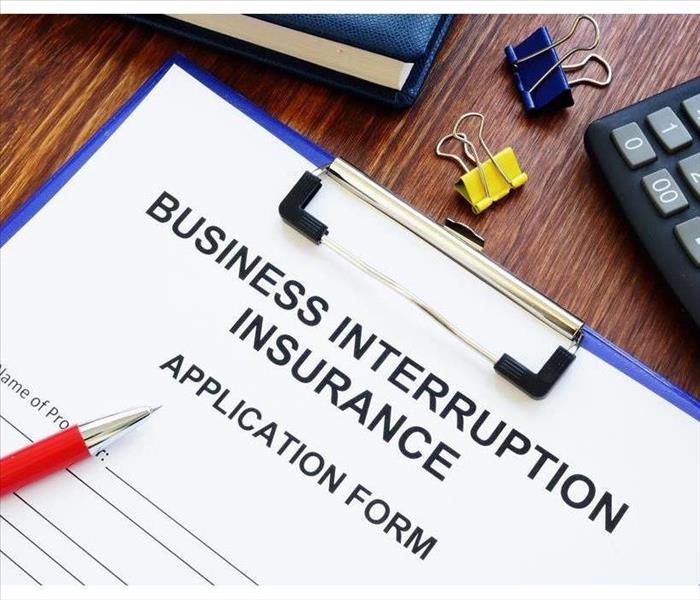 Interruption insurance usually starts when a business is closed due to a covered event.
Interruption insurance usually starts when a business is closed due to a covered event.
For your company to remain strong in difficult times, it will need a good insurance plan. The complete mix of insurance products will depend upon many things, but your company will require a comprehensive policy that protects against property damage and liability concerns. A complete or partial rebuild could cost many thousands of dollars. A major disaster could also cause your building in Cornwells Heights, PA, to shut down for days or even weeks. In these situations, your company could face a significant loss of business income, resulting in the inability to pay creditors, vendors and employees. Fortunately, there is insurance available for a business shutdown.
The Basics of Business Interruption Insurance
This type of insurance is typically added to your primary policy, which pays for such things as storm damage, fire damage, a rebuild or other covered perils. Interruption insurance usually starts when a business is closed due to a covered event. It typically helps with the following operational costs:
- Loan payments
- Loss of business income
- Expenses as a result of the closed business
- Employee payroll
- Taxes
- Rent or lease payments
Once your company is able to operate again, this type of insurance is no longer in effect. In some cases, depending upon your policy, you could get reimbursed for efforts to set up a temporary place of business.
The Basics of Successful Remediation
No matter what type of disaster your company faces, it might need the services of a professional storm remediation franchise. This highly-trained team can remove standing water from your facility caused by storms or floods. An assortment of technicians can remove excess moisture, clean and sanitize the building and restore damaged materials. They can return your building to its original condition.
If a rebuild is necessary, experienced professionals can complete the work efficiently. This allows your company to get back to work again in a timely manner.
Preparing Your Commercial Building for a Flood
4/20/2021 (Permalink)
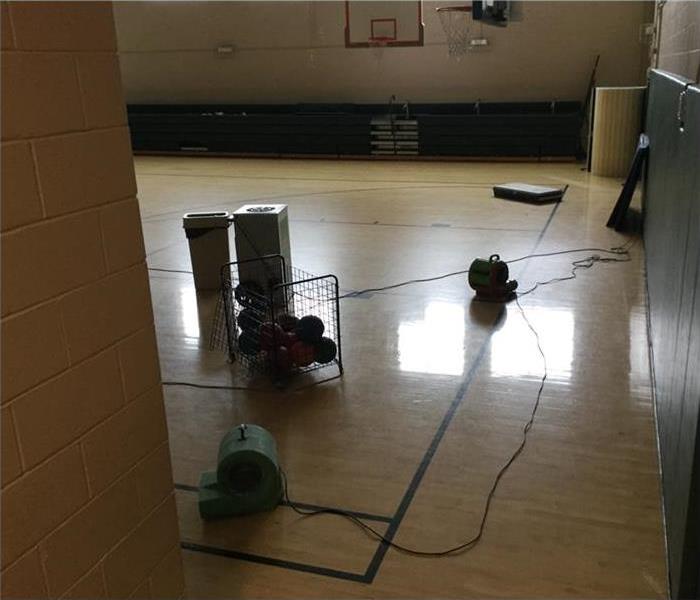 Commercial cleaning and restoration services in Langhorne, PA.
Commercial cleaning and restoration services in Langhorne, PA.
Flood Prevention Techniques
If your business in Langhorne, PA, is located in or near a high flood zone, flood insurance is a must. Flood insurance is available through the National Flood Insurance Program (NFIP) and can be added to your commercial building insurance plan. There are some flood prevention techniques you should also consider to reduce the risk of flooding.
1. Determine Your Base Flood Elevation
This calculation, known as the BFE, determines if your lowest floor is above or below the acceptable flood level. If it is below acceptable levels consider elevating the building at least 3 feet above the BFE, if possible. Contact your county's floodplain administrator for details in determining your BFE.
2. Install Flood-Resistant Materials
Use materials that are flood-resistant wherever possible. Water-resistant wall coverings, flooring and wall insulation will reduce the risk of water damage. Most of these materials can handle contact with water for about 72 hours before extensive damage occurs.
3. Utilize Dry Floodproofing Techniques
Flood prevention techniques, such as dry floodproofing, help to make your building watertight and keep floodwaters from invading your building.
Water-resistant shields should be placed over doors and windows located at or below the BFE. Water-absorbent sandbags, plastic tarps and sheeting should be placed in strategic areas around the building before the storm hits. These devices help to stave off shallow floodwaters.
Permanent swing flood doors or temporary flood gates can be installed to prevent deeper water from entering your building.
4. Invest in Backup Electrical Power
Consider purchasing backup power for your mechanical equipment and air conditioning system. Humidifiers and blowers help dry out materials quickly. If you find yourself in need of flood cleaning after a storm, however, don't attempt to tackle the problem yourself. Contact a water restoration service as soon as possible.
By implementing some smart flood prevention techniques, you can reduce the risk of severe damage to your building.
Dangerous Scenarios During and After a Storm
1/13/2021 (Permalink)
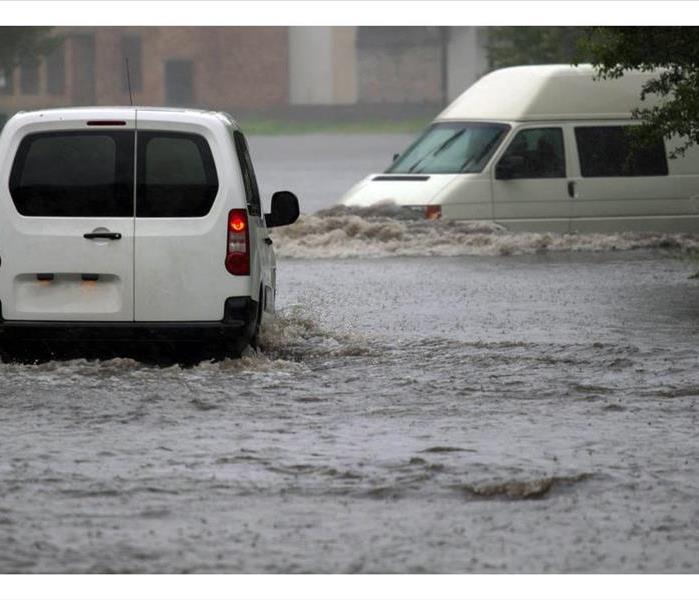 People should not travel during bad weather
People should not travel during bad weather
News reports are full of the many dangers that come with violent storms. Oftentimes these events lead to injury or even death for people caught in the middle of severe weather. A flooded street poses dangers for both pedestrians and drivers, while flooding is a problem for many homeowners in the area, so keep these tips in mind during a storm
Travel Tips
When at all possible, people should not travel during bad weather. Lightning, hailstorms, and flooded roads all pose serious dangers to travelers. Drivers should heed the following precautions during a storm:
- Only go out when absolutely necessary
- Carry a cell phone at all times
- Let loved ones know the travel itinerary
- Call 911 in an emergency
Never drive through a flooded street. It can be difficult if not impossible to determine the depth and strength of water over roadways. If the water is moving quickly, it can easily sweep a person of his or her feet. Experts state that as little as 12 inches of water can carry away a small vehicle, while 2 feet of moving water will wash even bigger cars down the road.
Persons who get trapped in high water in a vehicle should vacate the car or truck if it is safe to do so and immediately head to higher ground. If the water is moving swiftly, they should remain with the automobile.
Flood Cleanup
In addition to flooding the streets, it is more than likely the water will spill into the basements and ground floors of businesses and homes. When this happens, the services of a storm mitigation franchise can be indispensable. Trained technicians come to a property and work to bring a home back to normal. They use specialized equipment such as fans, vacuums, and air dryers to remove standing water, and know advanced techniques to get rid of odors, stains, and other forms of water damage.
Flooding in Penndel, PA, is bound to cause many problems, from a flooded street to a flooded basement. Take care to stay safe in such a disaster, both at and away from home.
How To Choose a Generator for Your Small Business
11/16/2020 (Permalink)
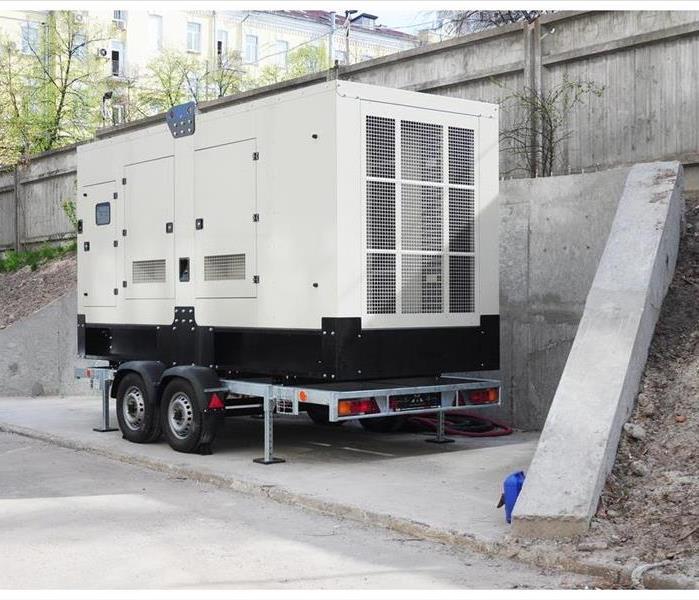 A commercial generator will automatically power on within minutes of a utility failure
A commercial generator will automatically power on within minutes of a utility failure
How Do You Choose A Suitable Commercial Generator?
When the power goes out in Fox Chase, PA, there’s a small time window during which perishable items can be saved. Having backup power is critical for any business, but how do you choose a suitable commercial generator? Here are three tips to help you get started.
1. Determine What Kind You Need
What are the power needs of your business? Depending on how you operate, you may need a portable or stationary unit. If you need power on the go, a towable unit makes it easy to do business at remote locations. Traditional businesses usually benefit from having a unit installed outside the building. Each kind of unit is connected differently but offers the same ability to back up your business's power.
2. Learn How To Use Your Machine
Once installed outside your property, a commercial generator will automatically power on within minutes of a utility failure. An electrician hardwires the unit into the building so you won’t have to worry about turning it on yourself. These machines can run off existing propane or natural gas lines, which makes refueling unnecessary. Alternatively, towable units run on diesel fuel and need to be manually connected to the site on arrival. Read the owner’s manual for these units so you know what to do when on location.
3. Provide Proper Maintenance
Check your machine after every major weather event or utility failure, especially if you’ve had an emergency that required professional water cleanup. Prolonged use with improper loads can cause generator problems, so consult your electrician for the correct sizing for the expected load. This, along with a regular maintenance schedule and high-quality fuel, can help your engine last for 10,000 to 30,000 hours (or 20-30 years).
When you have the right generator for your business, you don’t have to worry that a utility failure will cause irreparable damage to your assets. This critical unit keeps your business running until power is restored.
4 Ways To Prepare for Flood Damage
10/23/2020 (Permalink)
 Tune in to local news stations for weather reports
Tune in to local news stations for weather reports
Here Are Four Ways To Prepare For Flood Damage
Hurricanes and tropical storms can cause a devastating amount of damage, often leaving many people with costly repairs for their damaged homes, in Hulmeville, PA. Severe winds and heavy rains can cause flooding to occur rapidly, and it is important to take the necessary steps to prepare your home and mitigate any possible damage.
1. Stay Informed. Make sure you keep abreast of current weather conditions in your area. A weather radio is good to have on hand, but if you are unable to purchase one, you can tune in to local news stations for weather reports. You can also research your area to see if text or email alerts are available for inclement weather and emergency notifications.
2. Check Outside. Inspect the outside of your house for any areas that could leave your home susceptible to flash flooding. Clean gutters and storm drains and keep them free of any debris that could cause water backups. Check window seals and doors for any cracks that can allow water to seep in.
3. Prepare Inside. Protect your belongings by moving any documents, valuables and furniture off the ground. Move them to the highest floor in the house if you can. Install battery backups for your sump pumps to keep water out of the house if you lose power.
4. Know Who To Call. Be sure to have emergency contacts ready. In addition to having phone numbers of close friends and family to notify during an emergency, you should also keep the number of a professional storm cleanup and restoration company. These professionals are highly trained in storm damage and will help restore your home as quickly as possible and prevent any additional damage from occurring.
Flooding from storms and hurricanes can be terrifying and costly if you are not prepared. Proper planning and knowing who to call after the storm passes can help mitigate any losses or damage to your home.
Ways to Prevent Flooding in Your Building
9/5/2020 (Permalink)
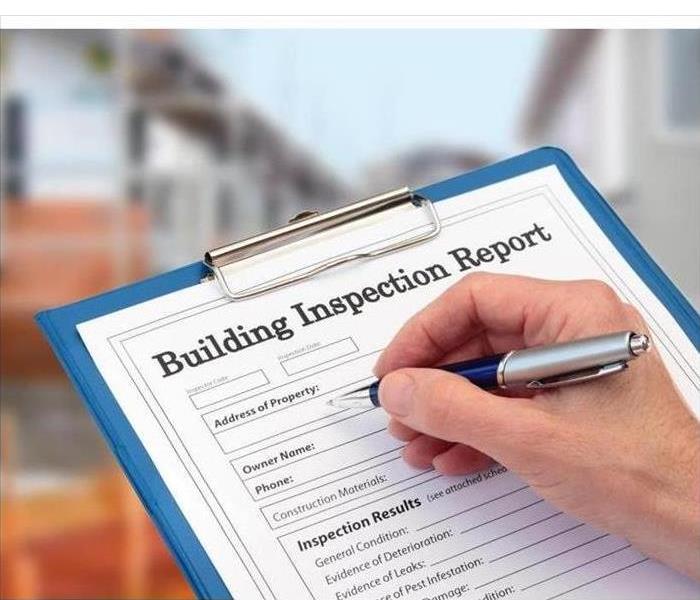 Inspect the outside of your building
Inspect the outside of your building
When flooding occurs in a commercial building, the costs can be devastating. In addition to property damage, employees may become displaced. Loss of profits can be monumental while renovations take place. While you can't protect your Cornwells Heights, PA, property in every circumstance, you can follow some smart flood prevention tips to help reduce the risks.
How To Protect Your Monetary Investment
The first step is to discuss your concerns with your insurance agent. Most commercial property insurance policies don't protect in the event of a flood or flood damage. Flood insurance is separate coverage that can be purchased through the National Flood Insurance Program. Your insurance company should be able to give you the contact information.
How To Keep Your Employees and Building Safe
If your commercial building is located in a flood plain or low-lying area, it is likely at a higher risk for flooding. Even buildings on higher ground can be susceptible, however. Listed below are some smart flood prevention ideas to protect your employees and your property, no matter where the building is located.
Set up a routine maintenance schedule to periodically inspect the outside of the building and the roof. Look for cracks or weaknesses in the foundation and seal any suspect areas right away. Carefully inspect the roof for damaged or missing shingles and other roofing materials. Replace any damaged materials as soon as possible. Gutters and drains must be cleaned of any dirt and debris. Sump pumps and generators should be inspected frequently to ensure that they function properly when needed.
Create an emergency action plan and train all employees in how to handle any type of emergency. The plan should include evacuation routes and meeting places for employees and visitors, as well as the location of emergency kits.
Even the business owner who implements the best flood prevention techniques may still have flooding in their building. If you are in need of flood cleaning, make sure you call a water damage expert as soon as possible.
What is a Nor'easter?
7/31/2020 (Permalink)
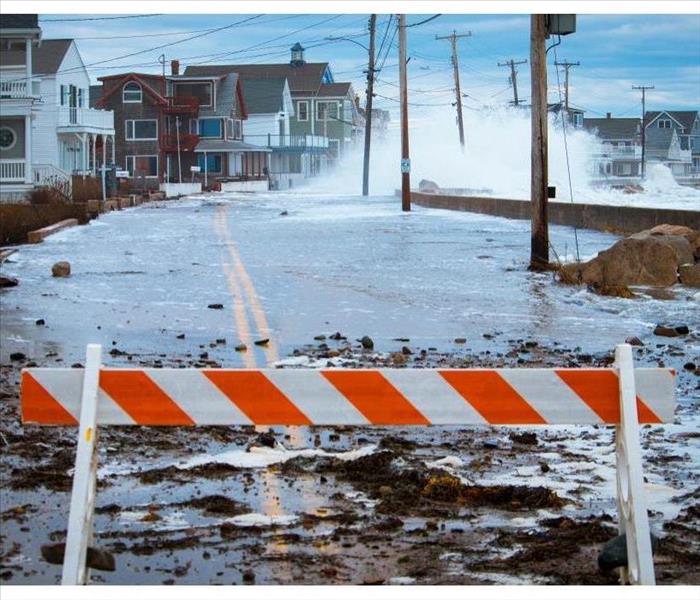 The nor'easter is among the most infamous winter storm patterns in the United States
The nor'easter is among the most infamous winter storm patterns in the United States
What Makes These Storms So Damaging?
The nor'easter is among the most infamous winter storm patterns in the United States. If you live in the eastern states, you are likely familiar with some of the downsides of having a home in the collision path of two opposing air currents, but you may still be wondering what makes these storms so damaging.
1. A Combination of Opposing Pressure Systems
Between the months of September and April, cold winds from Canada blow southward toward the Atlantic Ocean. Simultaneously, a warm ocean current heats the air, causing a low pressure system to form. The resulting clouds and precipitation soon move up the East Coast as a raging storm. Depending on the origin of air being redirected on the coast, experts refer to patterns as either Miller Type-A or Miller Type-B.
2. A Variety of Winter Weather
Chief among unknown nor'easter facts it that these events do not always produce the same weather phenomena. An infinite number of variables are responsible for winter storms, so snow, wind, rain, sleet and hail are all possible results of different conditions. You and your family should have a plan for flooding, extreme snowfall or high wind events. If you are not sure how to do this, ask a neighbor who has lived in your area for a long time.
3. An Event to Prepare for
Because a nor'easter can result in both damage to property and public infrastructure, it is advisable to keep plenty of supplies on hand during a storm. Some experts recommend keeping at least 3 full days of food stocked in your home in case snow or flooding leaves you stranded.
Read up on storms as much as you can. The more you know about winter weather patterns, the better you can prepare for the next weather event. If your Fox Chase, PA home has already been damaged by a nor'easter or winter storm, do not attempt complex restoration tasks on your own. Contact a storm restoration professional who has experience returning homes to working order.
Preparing Your Business for a Flood
7/6/2020 (Permalink)
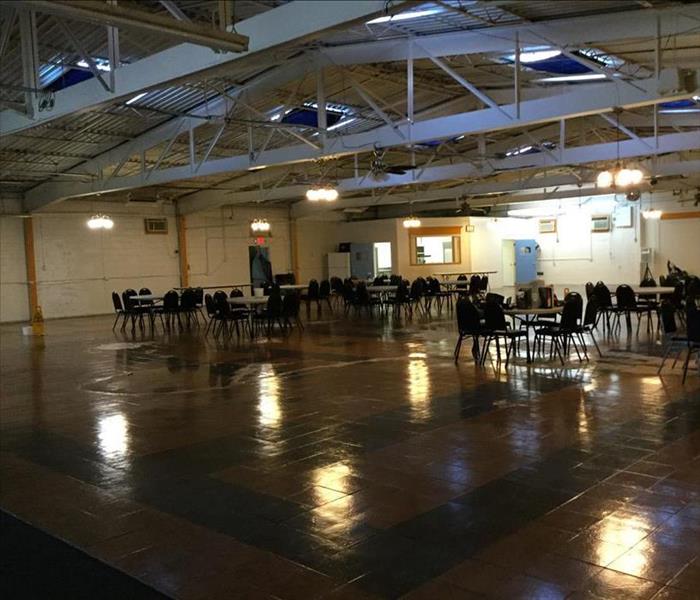 This Bensalem, PA commercial property was flooded after a rain storm. SERVPRO of Langhorne/Bensalem and Fox Chase/Torresdale was quick to the scene!
This Bensalem, PA commercial property was flooded after a rain storm. SERVPRO of Langhorne/Bensalem and Fox Chase/Torresdale was quick to the scene!
Storms can be unpredictable. A small rain shower can cause major flooding in a hurry. If you are not properly prepared, this disaster could destroy your business. That is why you should follow the below steps to mitigate any potential harm.
1. Be Aware
Some areas are more prone to floods than others. You can use FEMA's flood map to determine the risk in Bensalem, PA. This will help you prepare accordingly. While some flash floods are unpredictable, meteorologists can alert you when other floods are coming. To stay informed, sign up for a national and community emergency notification system.
2. Protect Your Assets
Any valuable electronics should be placed on higher levels where they are less likely to be affected by flooding. You likely have plenty of important documents in your commercial building, as well. Store them in waterproof containers and consider creating cloud or digital backups.
3. Get Supplies
If the flood occurs during business hours, you need to have certain supplies on hand for your employees. Have your workers create emergency kits in case they have to evacuate the area. The kits should include first aid equipment along with batteries and chargers.
After the Storm Even if you follow the above suggestions, you could still sustain some flood damage to your property. Avoid checking out the destruction in person until authorities say it is safe to do so.
In the meantime, you can contact a commercial building restoration company. You should call the cleanup pros as soon as possible so they can remove any dangerous black water. If you or your employees do go back in the building, keep an eye out for any snakes or other wildlife. Make sure that everyone knows to stay away from any wet electrical equipment, as well. Flooding can cause incredible damage in a short amount of time. While you cannot always predict when the next flood will occur, you can make sure your assets and employees are protected.
Make Sure That Your Solar Panels Can Withstand Storms
5/12/2020 (Permalink)
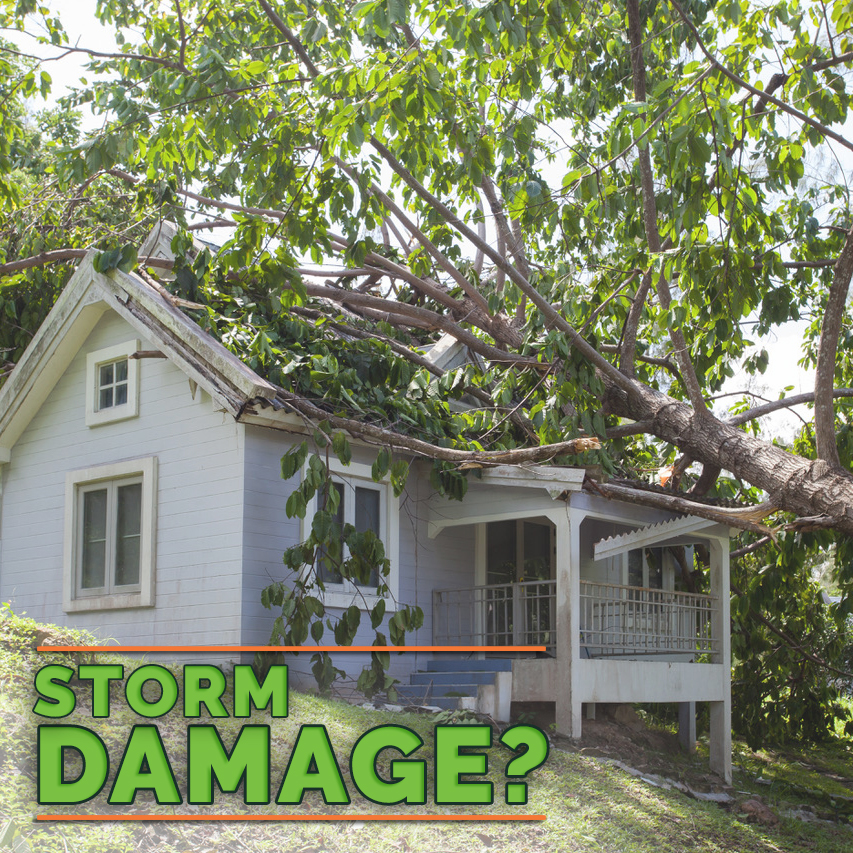 A tree falls on a local home during a storm in Langhorne, PA
A tree falls on a local home during a storm in Langhorne, PA
Solar panels are a great way to reduce energy usage in your home. Since they are installed on the outside of your house, they also take a beating from harsh hail and wind storms in Langhorne/Bensalem, PA. To reduce the risk of panel damage, keep these suggestions in mind.
How To Ensure My Panels Are Strong
The National Renewable Energy Laboratory (NREL) released a report in which they had conducted annual surveys of panel systems that had been installed from 2009 to 2013. Of the 50,000 systems surveyed, only 0.1% had shown damage or malfunctions. Part of the success can be attributed to the extensive testing conducted by panel manufacturers. Check to make sure your manufacturer has followed these guidelines.
Hail testing - Most panels are certified to resist panel damage caused by hail of up to 1 inch in diameter at 55 mph.
Hurricane testing - Most panels are tested to ensure they can withstand winds of up to 140 mph. The glass or aluminum castings that hold the panels are also waterproof.
How To Conduct Routine Maintenance on Panels
In order to ensure your panels continue to function properly, you should conduct routine maintenance.
Keep them clean - Dirt and debris can build up over time, so you should clean your panels on a regular basis with water. Also, brush away any tree branches that can hamper their functionality. While you are up there, check for roof damage and call a professional for repairs.
Install a panel cover - Even though panels are very sturdy, some come equipped with a cover. If so, make sure it is installed correctly by a professional.
Add a monitoring system - These systems, which must be installed by an expert, can detect and diagnose any problems with the system.
Installing solar panels will ensure that you are reducing your carbon footprint. Just make sure they are installed professionally to prevent panel damage or malfunctions.
How to Properly Make a Flood Damage Claim
5/7/2020 (Permalink)
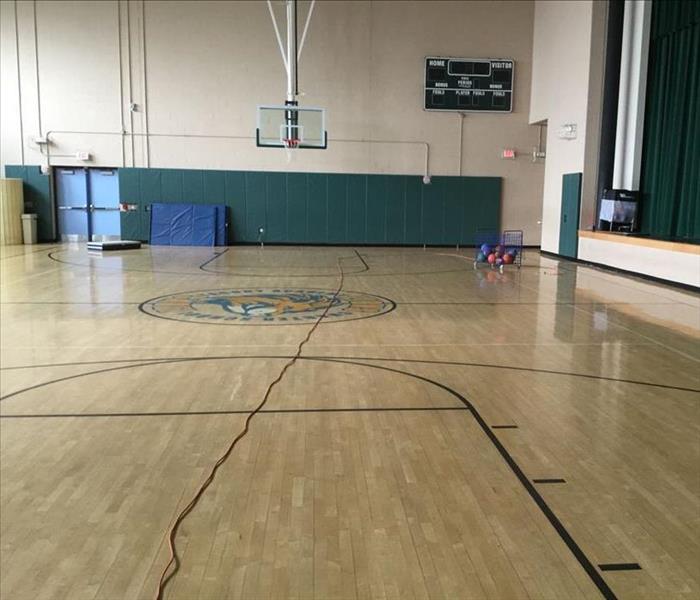 A flooded school in Langhorne, PA
A flooded school in Langhorne, PA
Water can inflict massive damage on your home if you're not careful. Though you can prepare yourself against many issues, some types of flooding may occur without warning. If you need to make a flood claim, there are ways you can help the process go more smoothly. Make sure you follow the following advice so you can get the financial help you need.
Gather Evidence
To make an insurance claim, your provider will want details about how the flood began and what was damaged or lost. Before you call your agent, it's best to do the following:
- Take pictures of the extent of the damage in your home.
- Write down belongings that were damaged or destroyed as well as building materials that were affected.
- Make note of any injuries you or family members may have suffered.
Get in Touch With the Professionals
Cleaning up after a flood can be time-consuming, pain-staking work. Unless the water damage is minor and only covers a small area, you should contact a professional water restoration company. These companies have skilled technicians with experience and the right equipment to clean up the water in your home. The professionals will arrive promptly and assess the situation. Crews will extract all the water, thoroughly dry and sanitize the area and restore any damaged or ruined materials. After you make a flood claim, the insurance company and the cleanup company will coordinate their efforts and work out a payment.
Stay out of the Way
One of the best things you can do after a disaster at home is to stay away from the incident area. Do not touch any damaged items or get near the water. This will keep you safe and prevent further issues with your Langhorne/Bensalem, PA home, and belongings.
Make sure you follow these steps when making a flood claim. You can get the compensation you need to restore your home and get back on your feet.
What You Need to Know About a Nor'easter
5/5/2020 (Permalink)
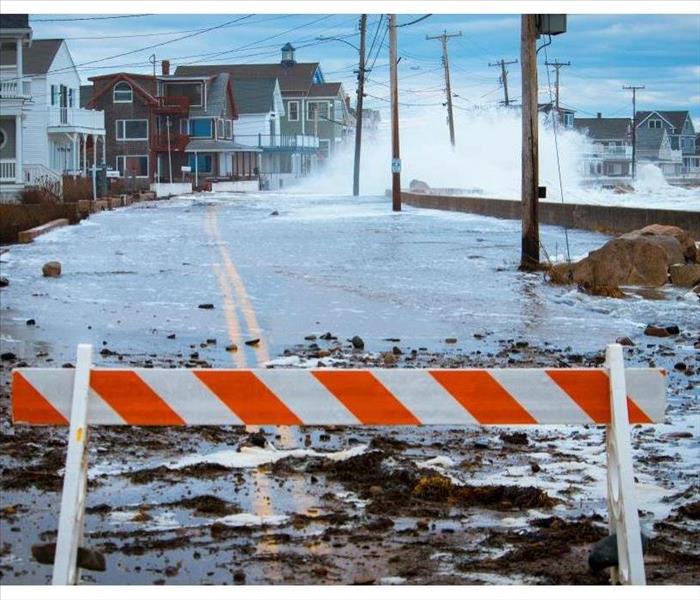 Keep safe all year by being alert and prepared for an approaching nor'easter
Keep safe all year by being alert and prepared for an approaching nor'easter
Anyone living on the Eastern Seaboard is familiar with a nor'easter storm. Thankfully, these storms don't hit too often, but when they do, they bring along heavy rain or snow, howling winds and stormy seas. To protect your home in Cornwells Heights, PA from flooding and other damage these storms can bring, let's take a look at some Nor'easter facts, including how the storms are formed and the trouble they can cause.
How Are These Storms Formed?
Two types of weather conditions can cause nor'easter storms, Miller Type A and Type B, as classified by J. E. Miller in 1946.
Miller Type A - These "classic" storms originate in the Gulf Coast and work their way up the coast to the Northeast. The storms are most common in the colder months of the year when cold air from the North travels down to the South where it meets much warmer air. This combination provides the perfection conditions for the storm.
Miller Type B - Much less common than the classic storms, these begin as cyclones in the Midwest that travel east. They break up somewhat in the Appalachian Mountains, then pick up steam again on the East Coast.
What Dangers Should You Be Aware Of?
In the winter months, these storms can cause heavy snow and wind. Power outages from downed trees and icy roads are common. To ensure your safety, keep abreast of weather conditions. Stock your pantry with enough food to get through the storm and stay at home when the storm approaches.
In warmer weather, strong winds and heavy rains can cause significant flooding and other damage to your home. Plan ahead by checking the weather report for any oncoming storms. Make sure your sump pump is in working order and your roof is in good shape. Keep your trees pruned to minimize the risk of downed tree branches.
Keep safe all year by being alert and prepared for an approaching nor'easter.
The Finances of Flood Damage
3/31/2020 (Permalink)
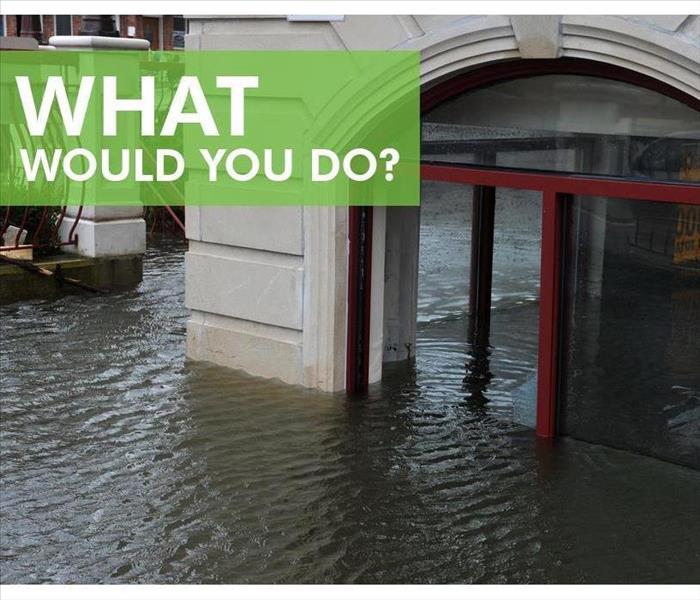 What would you do if your business flooded tomorrow?
What would you do if your business flooded tomorrow?
When a major storm hits your commercial business, it can be a financial disaster, too. Therefore it's important to pursue all of the potential benefits available to you. Repairing storm damage to your property can run into the thousands of dollars and many small businesses might not have sufficient savings to cover the expenses. Fortunately, your commercial insurance policy will cover some of these costs, after a deductible is paid. Other insurance options such as business interruption insurance and extra expense insurance may also kick in, though not all companies have this coverage. A number of expenses above and beyond an insurance claim could be tax deductible.
Looking Into Tax Benefits
When it comes to federal, state and local tax laws it always make sense to speak with a tax professionals. This allows you to claim all qualifying storm damage expenses. In general, the following expenses may be eligible for a tax write-off:
- Water damage expenses not paid by insurance
- Cleanup and recovery expenses
- Hurricane and tornado damage
Your initial efforts should concentrate on an insurance claim. An experienced storm mitigation team in Langhorne, PA, can help you organize your paperwork for the insurance company. With photos, spreadsheets and online communications an itemized record of expenses and losses can be sent to the insurance company. This enables a fast and efficient claims process that gets needed money into your hands fast.
Pursuing Other Options
If the storm damage that hits your company is part of a larger storm and has been declared a federal or state disaster area, other sources of financial help could become available. This includes low interest loans that help you borrow money to buy damaged equipment, replace lost inventory and pay employees. When disaster strikes, you need all of the help you can get or your company could never reopen. Working with companies and agencies that are Here to Help can make a big difference.
Sump Pump Losses
12/4/2019 (Permalink)
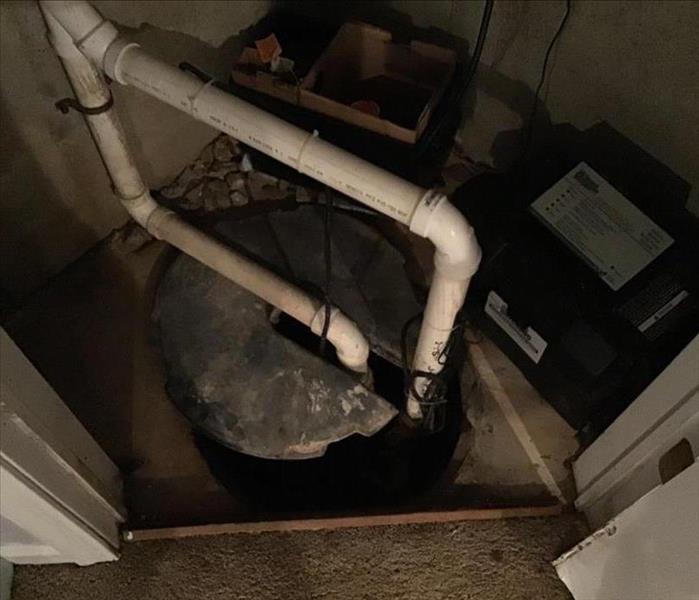 Pictured is an actual sump pump caught in the act of victimizing a local homeowner.
Pictured is an actual sump pump caught in the act of victimizing a local homeowner.
We see them all the time: significant storm events. It may be surprising to many homeowners that the most common damage in our area is caused, not by leaky windows or roofs, but by a sump pump failure. Whether it is due to temporary loss of electricity, or just the inability of the pump to function correctly, homeowners with a sump pump can sometimes experience a water damage. Add in a finished basement, that could be a recipe for a lot of damage! "And if you have a cut-rate insurance company policy, you could be paying for the repairs yourself."
So if you want to avoid mayhem, here are a few things you can do to protect yourself:
1) Speak to your insurance agent or provider to see about adding coverage to your policy specific to sump pumps. Many times, it is very low-cost to add this coverage, but insurance agents do not include it automatically. You don't want to find out after the damage!
2) While you will be anxious to get your property fixed, many times insurance coverage is limited on sump pump damage. Therefore, you may want to get an estimate first. The restoration company may need to see the property in-person to provide an accurate estimate, and this will surely delay the drying process, but it may ultimately save you dollars and cents.
So to sum up, make sure that you check your policy for coverage on sump pumps so that your insurance provider helps you with the repairs. And also be sure that you contact a reputable restoration company that is willing to provide you an estimate up front, like SERVPRO of Langhorne/Bensalem!
Summer Storm Carpet Damage
7/3/2019 (Permalink)
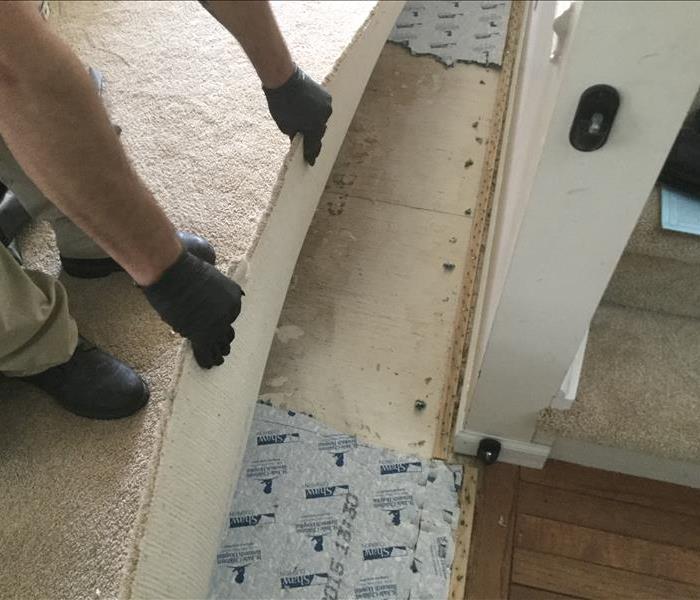 Carpet ruined in storm
Carpet ruined in storm
Here is a carpet that our team had to rip up the other day due to storm damage throughout the entire house. Water seeped through the upstairs, downstairs, and living room carpet. When we were called we were honest about saying we weren't sure if we could salvage the damage this time around because it was so severe. If this is the case, we have back up connections to refer out to help our potential clients just in case they need to get a hold of us in the future for any reason. This case however, ended up turning around and we figured out a way to save all of the carpet. Our customers were very pleased that they didn't need to pay for a new carpet and said they'll definitely be using our services again.
Storm Water in Basement
6/12/2019 (Permalink)
 Flooded nearby home
Flooded nearby home
Here is an example of damage that was done to the basement of a home nearby our office. The living room as well as the entire basement was completely under water from the storms we have been having recently. Our office was called in the middle of the night to tend to the job and we had majority of the damage cleared out by morning with a few air movers still placed for the remaining damage. We like to make it known to our customers that we are available any time of the day, no matter how severe the water damage--please don't hesitate to reach out. We are here to help and make your life a lot less stressful and easier during incidents as such.
Sump pump Damage
3/22/2019 (Permalink)
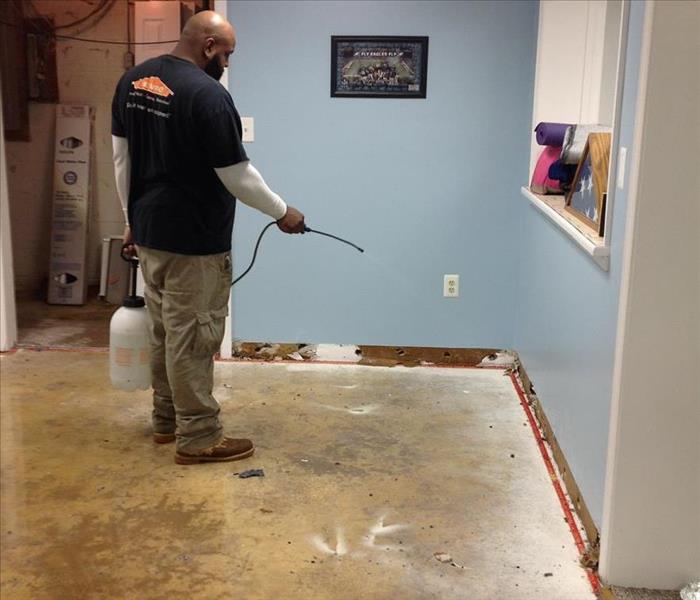 Clearing sump pump water damage
Clearing sump pump water damage
Over the course of the last couple weeks there have been numerous calls about water damage from Storms. We had a specific call the other day about a sump bump that overflowed due to all the water from the rain. Our client was very worried about the damage and did not want to wait until the weekend was over to take care of the issue. Our team was readily available for them and we arrived at their house the next day to take care of the issue. SERVPRO prides themselves on efficiency and gets the job done as fast as possible each time. If yourself, friend, family member, etc.--ever needs our services last minute, please pick up the phone and call SERVPRO! We're always here to help.
Townhome Storm Damage
3/18/2019 (Permalink)
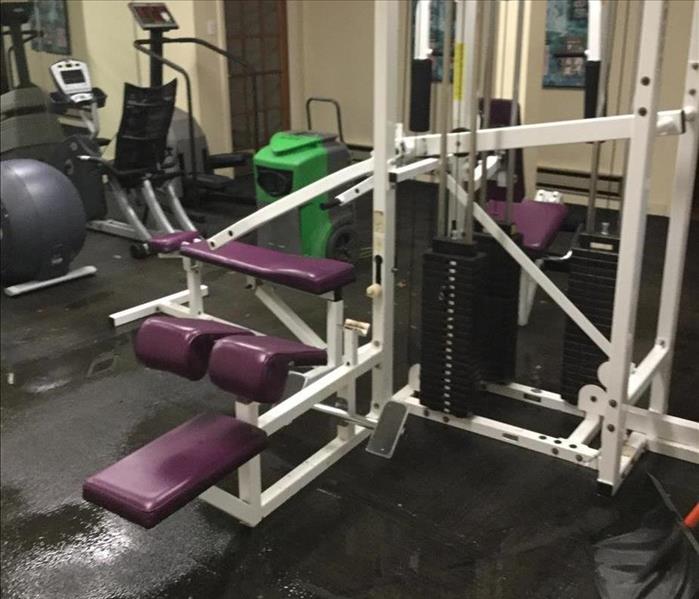 Pool water overflow into gym
Pool water overflow into gym
Here is an example of a job we received a call for a few weeks ago after a big storm had hit. An apartment complex's pool overflowed into the gym and basement as well. Our team was called in quickly to tend to the issue to dry out the damage. While we were there we also tended to some of the units since there was some water that had seeped through the ceilings, too. The property manager was very impressed with our work and stated that from there on out, we would be his main point of contact for emergencies in case something were to happen again. If and when storm damage happens on your property, whether it be commercial or residential--please don't hesitate to call SERVPRO!
Moving Out
3/15/2019 (Permalink)
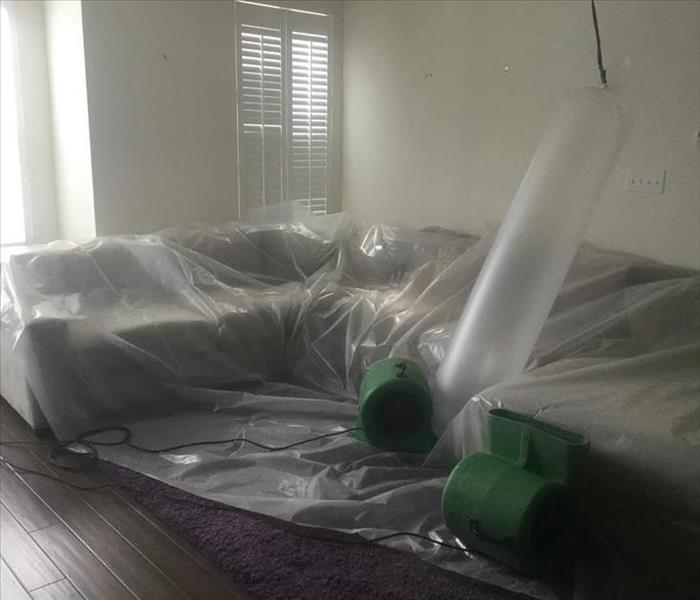 Storm Damage to furniture
Storm Damage to furniture
This is an example of a customer who called us urgently with a concern when she was moving out. There had been a storm recently and there was severe water damage done to all our client's furniture. We used a couple of creative drying methods (more plastic and tubes like the attached picture) to save the most of the building materials and her couch. She was thrilled with how fast we got everything done and how many items we were able to salvage, since she was right in the midst of moving out of her home. SERVPRO is here to take care of any of your drying needs--from floors to counter tops, to couches and more. Please don't hesitate to give us a call if you're feeling stressed at all. We're here to help!
Disaster Preparation
11/30/2018 (Permalink)
Don't know how to shut off your utilities right before a disaster strikes? Here's what you need to know:
During cases of emergency, power surges after the storm can damage electronics, and flooded appliances can also create safety hazards.
- Shut off all the individual circuits, then turn off your main circuit. It is also useful to label the individual circuits.
- Shut off your water.
- Cracked lines can also pollute your water supply to your home, so check in with local authorities before restoring your water.
- Shut off your natural gas.
- Locate the shutoff valve connected to the gas line, and turn the switch perpendicular to stop the gas flow.
- If you expect a gas leak, immediately evacuate the house and DO NOT turn off your gas. Contact your local natural gas provider, and have a professional assess the situation. Natural gas leaks are attributed to numerous home fires.
How will YOU prepare?






 24/7 Emergency Service
24/7 Emergency Service












